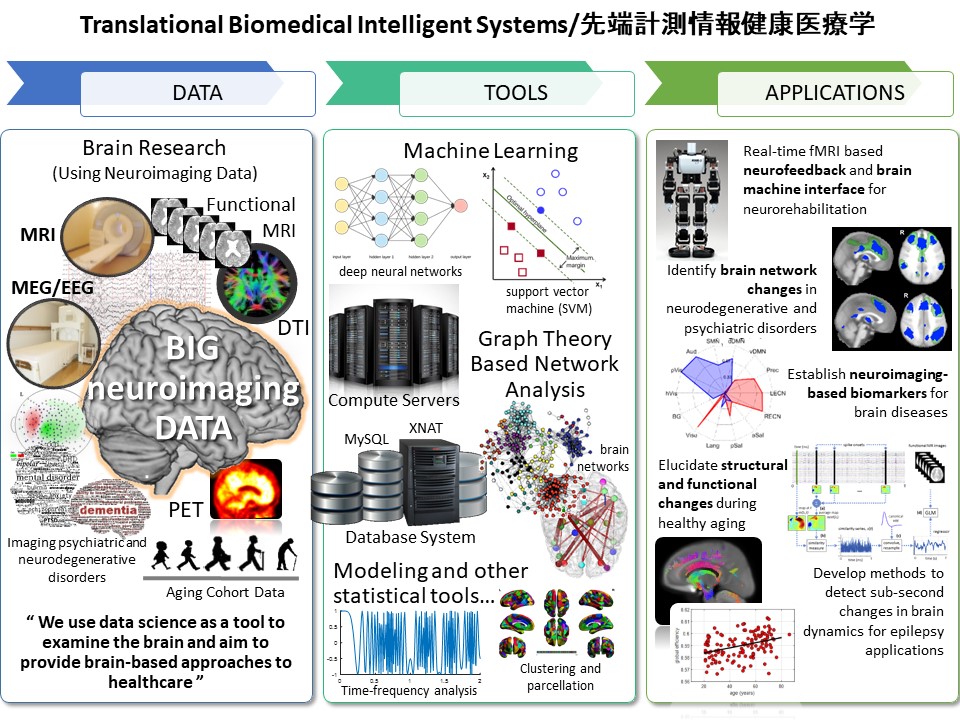
Overview
The primary research focus of TBIS is the human brain, the central organ of the nervous system. The brain is a very complex system consisting of about 90 billion neurons and roughly 150 trillion connections. Because of this immense complexity, our understanding of the brain is very limited. As a consequence, causes of neurological and psychiatric disorders such as Alzheimer’s disease, Parkinson’s disease, epilepsy, autism spectrum disorder, schizophrenia, and depression, among others, affecting individual, families, and societies, remain largely unknown. According to the World Alzheimer’s Report in 2015, someone in the world develops dementia every 3 seconds and, by 2030, the total estimated worldwide cost of dementia will reach US$ 2 trillion.
It is therefore not surprising why the brain has gained significant research attention in the past decade or two as evidenced by several big brain projects or initiatives undertaken by governments across the world such as the United States of America, the European Union, Japan, and many others. Examples include the BRAIN Initiative in the US, the Human Brain Project in the EU, the Brain/MINDS in Japan, and several others. As a result, huge amount of neuroimaging data are continuously being generated. In a drive towards open science, these BIG DATA are also becoming more accessible to researchers around the world.
Closer to home, the Brain & Mind Research Center of Nagoya University has an ongoing Aging Cohort Study, which aims to scan 1,000 healthy volunteers across the adult lifespan. Using neuroimaging data such as resting state functional magnetic resonance imaging(rs-fMRI), diffusion-weight MRI (dMRI), structural MRI, and magnetoencephalography (MEG), among others, one of the study’s goals is to investigate alterations in the brain’s structure and function during healthy aging. There are also other studies involving participants with neurological (Alzheimer’s disease, Parkinson’s disease, multiple systems atrophy, amyotrophic lateral sclerosis, epilepsy, etc) and psychiatric (schizophrenia, autism spectrum disorder, bipolar disorder, etc) disorders. Data from these studies may also be accessible after obtaining permission from relevant researchers.
Research Topics
Research topics pursued by researchers belonging to the unit are mostly related to the brain. Below are some of these topics currently undertaken by the unit.
- Development and applications of real-time functional MRI. This study aims to develop a real-time functional MRI system using the MRI scanner available at the Daiko campus. Real-time fMRI is a novel technique that enables the acquisition and analysis of functional magnetic resonance images in real-time. Real-time functional MRI has enabled the development of novel methods to probe brain functions in almost real-time. With real-time fMRI, ongoing brain activity can be detected and analyzed leading to application such as neurofeedback, which could help participants learn to control the activity of their brain using real-time feedback information. Real-time fMRI could also be used in brain computer/machine interfaces, which has the potential for neuro-rehabilitation.
- BMRC aging cohort study. This is an ongoing study of the Brain and Mind Research Center (BMRC), Nagoya University. Using several imaging modalities, such as resting state fMRI, T1- and T2-weighted MR images, diffusion tensor imaging (DTI), and magnetoencephalography (MEG), the study aimed to investigate the effects of healthy aging in the brain. We’ve investigated age-related changes in resting state networks using independent component analysis and graph theory, in fractional anisotrophy and white matter microstructural changes using DTI, and in gray matter atrophy using anatomical T1-weighted images.
- Development of neuroimaging-based biomarkers for neurological or psychiatric disorders. In this study, multimodal neuroimaging data are used to identify characteristic changes in brain networks (“connectome”) associated with different neurological and psychiatric disorders. The study leverages on existing big neuroimaging data from BMRC’s ongoing aging cohort study of healthy controls and several studies involving patients with neurological and psychiatric disorders to examine disease-specific changes in the brain connectome, identify a connectome-informed signature of each disorder, and use these signatures to develop a biomarker. This biomarker could be used to provide more objective, direct, brain-based diagnostic information of the disease, discriminate different neurological and psychiatric disorders, and elucidate progression of brain network changes across different disease stages or subtypes, among others.
For students
As the amount of neuroimaging data explodes, the need for individuals, researchers, and scientists who can apply the full spectrum of modern computational techniques to these data also grows. For students, this is an opportunity to explore and learn the tools of data science irrespective of their specific courses. The Translational Biomedical Intelligent Systems unit of the Department of Integrated Health Sciences provides opportunities to learn these tools and to apply this knowledge to solve specific problems relating to the brain, its functions and organization, in health and diseased state.